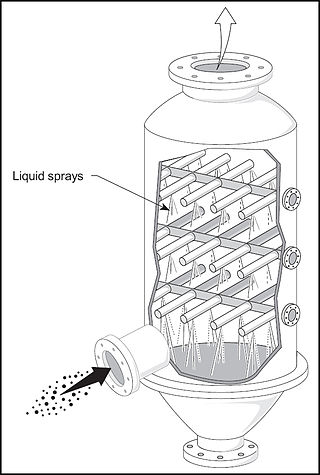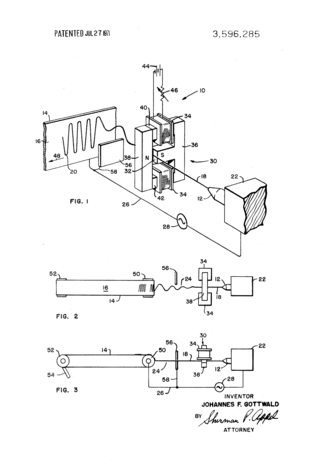Related Research Articles

Microfluidics refers to a system that manipulates a small amount of fluids using small channels with sizes ten to hundreds micrometres. It is a multidisciplinary field that involves molecular analysis, molecular biology, and microelectronics. It has practical applications in the design of systems that process low volumes of fluids to achieve multiplexing, automation, and high-throughput screening. Microfluidics emerged in the beginning of the 1980s and is used in the development of inkjet printheads, DNA chips, lab-on-a-chip technology, micro-propulsion, and micro-thermal technologies.

Inkjet printing is a type of computer printing that recreates a digital image by propelling droplets of ink onto paper and plastic substrates. Inkjet printers were the most commonly used type of printer in 2008, and range from small inexpensive consumer models to expensive professional machines. By 2019, laser printers outsold inkjet printers by nearly a 2:1 ratio, 9.6% vs 5.1% of all computer peripherals.
Flow measurement is the quantification of bulk fluid movement. Flow can be measured using devices called flowmeters in various ways. The common types of flowmeters with industrial applications are listed below:
A propellant is a mass that is expelled or expanded in such a way as to create a thrust or another motive force in accordance with Newton's third law of motion, and "propel" a vehicle, projectile, or fluid payload. In vehicles, the engine that expels the propellant is called a reaction engine. Although technically a propellant is the reaction mass used to create thrust, the term "propellant" is often used to describe a substance which contains both the reaction mass and the fuel that holds the energy used to accelerate the reaction mass. For example, the term "propellant" is often used in chemical rocket design to describe a combined fuel/propellant, although the propellants should not be confused with the fuel that is used by an engine to produce the energy that expels the propellant. Even though the byproducts of substances used as fuel are also often used as a reaction mass to create the thrust, such as with a chemical rocket engine, propellant and fuel are two distinct concepts.

Digital microfluidics (DMF) is a platform for lab-on-a-chip systems that is based upon the manipulation of microdroplets. Droplets are dispensed, moved, stored, mixed, reacted, or analyzed on a platform with a set of insulated electrodes. Digital microfluidics can be used together with analytical analysis procedures such as mass spectrometry, colorimetry, electrochemical, and electrochemiluminescense.

A surface acoustic wave (SAW) is an acoustic wave traveling along the surface of a material exhibiting elasticity, with an amplitude that typically decays exponentially with depth into the material, such that they are confined to a depth of about one wavelength.
Electrowetting is the modification of the wetting properties of a surface with an applied electric field.
A vacuum ejector, or simply ejector is a type of vacuum pump, which produces vacuum by means of the Venturi effect.
The integrated nanoliter system is a measuring, separating, and mixing device that is able to measure fluids to the nanoliter, mix different fluids for a specific product, and separate a solution into simpler solutions.

A liquid handling robot is used to automate workflows in life science laboratories. It is a robot that dispenses a selected quantity of reagent, samples or other liquid to a designated container.

A spray tower is a gas-liquid contactor used to achieve mass and heat transfer between a continuous gas phase and a dispersed liquid phase. It consists of an empty cylindrical vessel made of steel or plastic, and nozzles that spray liquid into the vessel. The inlet gas stream usually enters at the bottom of the tower and moves upward, while the liquid is sprayed downward from one or more levels. This flow of inlet gas and liquid in opposite directions is called countercurrent flow.

A spray nozzle or atomizer is a device that facilitates the dispersion of a liquid by the formation of a spray. The production of a spray requires the fragmentation of liquid structures, such as liquid sheets or ligaments, into droplets, often by using kinetic energy to overcome the cost of creating additional surface area. A wide variety of spray nozzles exist, that make use of one or multiple liquid breakup mechanisms, which can be divided into three categories: liquid sheet breakup, jets and capillary waves. Spray nozzles are of great importance for many applications, where the spray nozzle is designed to have the right spray characteristics.

Ultrasonic nozzles are a type of spray nozzle that use high frequency vibrations produced by piezoelectric transducers acting upon the nozzle tip that create capillary waves in a liquid film. Once the amplitude of the capillary waves reaches a critical height, they become too tall to support themselves and tiny droplets fall off the tip of each wave resulting in atomization.
Microdispensing is the technique of producing liquid media dosages in volumes of less than one microlitre. The continuing miniaturization in almost all technical areas creates constant challenges for industry, development and research facilities. Microdispensing is one of those challenges. Ever smaller amounts of adhesive, liquid, oil, grease and a multitude of other media must be dispensed reliably and accurately in dosage and placement with short cycle times. The precise positioning and quantity of fluids such as glue, reagents or any other substance has a great influence on the overall quality of a medical device. A few examples are:

A spray is a dynamic collection of drops dispersed in a gas. The process of forming a spray is known as atomization. A spray nozzle is the device used to generate a spray. The two main uses of sprays are to distribute material over a cross-section and to generate liquid surface area. There are thousands of applications in which sprays allow material to be used most efficiently. The spray characteristics required must be understood in order to select the most appropriate technology, optimal device and size.
The liquid droplet radiator (LDR) or previously termed liquid droplet stream radiator is a proposed lightweight radiator for the dissipation of waste heat generated by power plants, propulsion or spacecraft systems in space.

Inkjet technology originally was invented for depositing aqueous inks on paper in 'selective' positions based on the ink properties only. Inkjet nozzles and inks were designed together and the inkjet performance was based on a design. It was used as a data recorder in the early 1950s, later in the 1950s co-solvent-based inks in the publishing industry were seen for text and images, then solvent-based inks appeared in industrial marking on specialized surfaces and in the1990's phase change or hot-melt ink has become a popular with images and digital fabrication of electronic and mechanical devices, especially jewelry. Although the terms "jetting", "inkjet technology" and "inkjet printing", are commonly used interchangeably, inkjet printing usually refers to the publishing industry, used for printing graphical content, while industrial jetting usually refers to general purpose fabrication via material particle deposition.
Droplet-based microfluidics manipulate discrete volumes of fluids in immiscible phases with low Reynolds number and laminar flow regimes. Interest in droplet-based microfluidics systems has been growing substantially in past decades. Microdroplets offer the feasibility of handling miniature volumes of fluids conveniently, provide better mixing, encapsulation, sorting, sensing and are suitable for high throughput experiments. Two immiscible phases used for the droplet based systems are referred to as the continuous phase and dispersed phase.
Capillary breakup rheometry is an experimental technique used to assess the extensional rheological response of low viscous fluids. Unlike most shear and extensional rheometers, this technique does not involve active stretch or measurement of stress or strain but exploits only surface tension to create a uniaxial extensional flow. Hence, although it is common practice to use the name rheometer, capillary breakup techniques should be better addressed to as indexers.
Rotary atomizers use a high speed rotating disk, cup or wheel to discharge liquid at high speed to the perimeter, forming a hollow cone spray. The rotational speed controls the drop size. Spray drying and spray painting are the most important and common uses of this technology.
References
- ↑ R. W. Wood; A. L. Loomis (1927). "The Physical and Biological Effects of High Frequency Sound Waves of Great Intensity". Philosophical Magazine. 4 (22): 417–436.
- ↑ K. A. Krause (1973). "Focusing Ink Jet Head". IBM Technical Disclosure Bulletin. 16 (4): 1168.
- ↑ R. Ellson; M. Mutz; B. Browning; L. Lee; M.F. Miller; R. Papen (2003). "Transfer of Low Nanoliter Volumes between Microwell Plates Using Focused Acoustics – Automation Considerations". Journal of the Association for Laboratory Automation. 8 (5): 29–34. doi:10.1016/S1535-5535(03)00011-X.
- ↑ R. Ellson (2002). "Picoliter: enabling precise transfer of nanoliter and picoliter volumes". Drug Discovery Today. 7 (5): 32–34. doi:10.1016/S1359-6446(02)02176-1.
- ↑ J. Comley (2004). "Continued Miniaturisation of Assay Technologies Drives Market for Nanolitre Dispensing". Drug Discovery World. Summer: 43–54.
- ↑ Yin, Xingyu; Scalia, Alexander; Leroy, Ludmila; Cuttitta, Christina M.; Polizzo, Gina M.; Ericson, Daniel L.; Roessler, Christian G.; Campos, Olven; Ma, Millie Y.; Agarwal, Rakhi; Jackimowicz, Rick; Allaire, Marc; Orville, Allen M.; Sweet, Robert M.; Soares, Alexei S. (2014). "Hitting the target: fragment screening with acoustic in situ co-crystallization of proteins plus fragment libraries on pin-mounted data-collection micromeshes". Acta Crystallographica Section D. 70 (5): 1177–1189. doi:10.1107/S1399004713034603. PMC 4014116 . PMID 24816088.